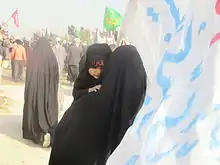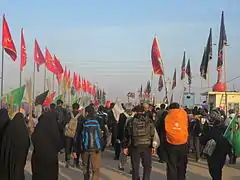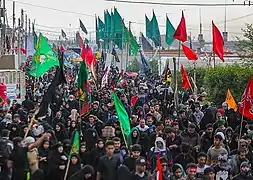| Arba'in pilgrimage | |
|---|---|
 Arba'in pilgrims near the shrine of Husayn ibn Ali, grandson of the Ismalic prophet Muhammad and the third Shia imam | |
| Status | Active |
| Genre | Religious gathering |
| Date(s) | Arba'in (twentieth of Safar) |
| Frequency | Annually |
| Location(s) | Karbala, Iraq |
| Participants | Shia Muslims |
| Part of a series on |
| Husayn |
|---|
|
| Part of a series on Shia Islam |
|---|
 |
|
|
The Arba'in pilgrimage is the world's largest annual public gathering. It is a pilgrimage to the shrine of Husayn ibn Ali, grandson of the Islamic prophet Muhammad and the third Shia imam. Every year, on the twentieth of Safar, also known as Arba'in, millions of pilgrims flock to Karbala, Iraq, often arriving there on foot from the nearby city of Najaf. Arba'in marks forty days after the tenth of Muharram, known as Ashura. On this day in 61 AH (680 CE), Husayn was killed, alongside most of his relatives and his small retinue, in the Battle of Karbala against the army of the Umayyad caliph Yazid ibn Mu'awiya (r. 680–683). The battle followed Husayn's refusal to pledge his allegiance to Yazid, who is often portrayed by Muslim historians as impious and immoral. In Shia Islam, Karbala symbolizes the eternal struggle between good and evil, the pinnacle of self-sacrifice, and the ultimate sabotage of Muhammad's prophetic mission.
Forty is a sacred number in Islam, and the Arba'in pilgrimage is an early Shia tradition popularized by the Shia imams. In recent times, the Arba'in pilgrimage was banned by the Iraqi president Saddam Hussein, but rapidly grew after his deposal in 2003 from two million participants in that year to around twenty million in 2014. Nevertheless, the voluntary Arba'in pilgrimage remains largely unknown in the West, even though it is far larger than Hajj, the obligatory Muslim pilgrimage. As with Ashura, Arba'in can be an occasion for Sunni violence against Shia Muslims. During the pilgrimage, free meals and accommodation are provided by volunteers.
Significance of Arba'in in Shia Islam
In the Islamic calendar, twentieth of Safar is known as Arba'in,[1][2] which marks forty days after Ashura, tenth of Muharram.[3] In turn, Ashura is the death anniversary of Husayn ibn Ali, grandson of the Islamic prophet Muhammad and the third Shia imam.[4] Husayn was killed on 10 Muharram 61 AH (10 October 680 CE), alongside most of his male relatives and his small retinue, in the Battle of Karbala against the army of the Umayyad caliph Yazid ibn Mu'awiya (r. 680–683), having been surrounded for some days and deprived of the drinking water of the nearby Euphrates river. After the battle, women and children in Husayn's camp were taken prisoner and marched to the Umayyad capital Damascus in Syria. The battle followed failed negotiations and Husayn's refusal to pledge his allegiance to Yazid, who is often portrayed by Muslim historians as impious and immoral.[5][6][7] The fight took place in the desert land of Karbala, en route to the nearby Kufa, whose residents had earlier invited Husayn to lead them against Yazid.[8]
In Shia Islam, Karbala symbolizes the eternal struggle between good and evil,[9][10] the pinnacle of self-sacrifice,[11] and the ultimate sabotage of Muhammad's prophetic mission.[12] Historically, the event served to crystallize the Shia community into a distinct sect and remains an integral part of their religious identity to date.[13][14] Ashura to Arba'in is thus a period of mourning for Shia Muslims,[15] particularly the first ten days of Muharram and Arba'in.[16][3][17] On the one hand, Shia mourners hope to share in the pain of Husayn to benefit from his intercession on the Day of Judgement.[18][19] On the other, the Shia minority views mourning for Husayn as an act of protest against oppression, and as such a struggle for God (jihad).[20][21]
Origins of the Arba'in pilgrimage
Forty is a sacred number in Islam,[3] and commemorating the dead forty days after their death is a long-standing Islamic tradition,[22][23][3] dating back to the early Islamic period.[22] Shia tradition attaches a similar significance to Arba'in, the fortieth of Husayn.[22] Probably by combining the accounts available to him,[22] the Shia scholar Ibn Tawus (d. 1266) reports that Husayn's relatives returned via Karbala to their hometown of Medina when they were freed from captivity in Damascus. Upon arrival in Karbala on Arba'in,[24][25] they met Jabir ibn Abd Allah (d. 697), a companion of Muhammad,[22] who had learned about the death of Husayn through a divine sign.[3] This origin story was repeated by many authors after Ibn Tawus, even though several scholars before Ibn Tawus report only the Arba'in pilgrimage of Jabir.[22] The veracity of Ibn Tawus' account has therefore been questioned by some, including the Shia scholar Husain Noori Tabarsi (d. 1902) and the Islamicist Mahmoud M. Ayoub (d. 2021).[22][3] Ayoub adds that Arba'in is not mentioned in Kamil al-ziyarat, an early and authoritative hadith collection by the Shia traditionist Ibn Qulawayh (d. c. 978).[3] Whatever the case, such narratives may have helped establish Arba'in in Shia culture.[22]
Risking the Umayyads' wrath, the commemoration of Karbala was initially small and private.[26][27] In particular, pilgrimage to Karbala remained limited and precarious during the Umayyad period.[28] Soon after the Umayyads fell, however, Shia imams worked to institutionalize the Ashura and Arba'in pilgrimages to the tomb of Husayn, as reflected in some of the traditions ascribed to the imams. For instance, the Shia imam Hasan al-Askari (d. c. 874) is reported to have listed the Arba'in pilgrimage among the five signs of a true believer.[22]
Largest annual gathering


Arba'in is a day of pilgrimage to the shrine of Husayn in Karbala, Iraq. Pilgrims arrive there in large numbers, often on foot. The most popular route is Najaf to Karbala, as many pilgrims first travel to Najaf and then walk from there to Karbala, some eighty kilometers away, which takes about three days on foot. Along the way, volunteers provide the pilgrims with free meals and services.[29] In Karbala alone, seven thousand of such hospitality units (mawakib, SG mawkib) were set up in 2014.[30] Indeed, this generosity and hospitality are said to characterize the Arba'in pilgrimage. When the pilgrims finally reach the shrine of Husayn in Karbala, they recite the ziyara of Arba'in, a supplication for this occasion.[29]
As with other Shia rituals of Karbala,[31] the Arba'in pilgrimage was banned by the Iraqi president Saddam Hussein (r. 1979–2003),[32] who favored the Sunni community in Iraq,[31] and viewed large Shia rituals as a political threat.[32] The pilgrimage was revived immediately after the deposal of Saddam in 2003,[32] with numbers growing from two million participants in that year to nine million in 2008,[32][33] and around twenty million in 2014,[34][35] making that year's pilgrimage the second largest gathering in history.[36] The figure reached twenty-two million in 2015, according to Iraq's state-run media.[37] In 2016, al-Khoei Foundation estimated around twenty-two million pilgrims.[38] Even though the Hindu festival Kumbh Mela draws a larger crowd, it is held once every three years, which makes the Arba'in pilgrimage "the world's largest annual gathering in one place."[39]
Comparison to Hajj
Unlike the voluntary Arba'in pilgrimage, performing Hajj once is obligatory for every Muslim who can afford it and is physically capable. Nevertheless, tight regulations on Hajj by Saudi authorities have driven up its costs, making pilgrimage to Shia shrines an affordable alternative for Shia Muslims. In recent years, Karbala has consistently received ten to twenty million pilgrims, compared to less than three million Hajj pilgrims in 2018.[40]
Free services
During the pilgrimage "copious supplies of food, small clinics and even dentists are available for pilgrims and they all work for free. The care of pilgrims is regarded as a religious duty."[41] Along the roads to Karbala, mawakib provide "accommodation, food and beverage and medical services," and practically anything else the pilgrims need for free.[42]
Security aspects
As with Ashura,[43] Arba'in can be an occasion for Sunni violence against Shia Muslims.[44][45][46] For instance, a suicide bomber killed at least forty-four Arba'in pilgrims and wounded some seventy others in 2012 near Nasiriya, Iraq.[47] In another attack in 2013, at least twenty pilgrims were killed and another fifty were wounded by a car bomb.[48] The pilgrimage is therefore performed under tightened security, guarded by tens of thousands of Iraqi forces,[49] and supported by Iranian advisers at least in 2015.[50] In the same year, the Iraqi police seized eighteen booby-trapped dolls, stuffed with explosives, which were intended to be scattered on the roads leading to Karbala during the Arba'in pilgrimage.[51][52]
Political dimension
As with other Shia rituals of Karbala,[31] the Arba'in pilgrimage was banned by Saddam Hussein,[32] who favored the Sunni minority in Iraq,[31] and viewed Shia rituals as a political threat.[32] The pilgrimage was revived immediately after his deposal in 2003 and that year's march to Karbala thus symbolized Shia defiance of Sunni regional powers. The 2003 pilgrimage also set off a regional wave of Sunni violence against the Shia minority as scores of Shia mourners were killed in multiple bombings in the following Ashura.[53] Later on, as millions of Shias risked their lives by their participation, the Arba'in pilgrimage embodied their protests against the rise of ISIL, a Sunni extremist militant group with aspirations for a hardline Sunni caliphate and responsible for several Shia massacres.[35][54] In recent years, the participation of non-Iraqi Shias in the Arba'in pilgrimage has fostered a sense of solidarity among Shias. In particular, the unprecedented Iranian attendance in recent pilgrimages could be an indication of Iran's victories against its Sunni regional rivals. Yet the Arba'in pilgrimage also exposes the rivalries between different political currents within the Shia community.[35]
In the media
Media blackout
The Arba'in pilgrimage remains largely unknown in the West, even though it is far larger than Hajj.[54] Some have therefore accused the Western media of censoring or minimizing the annual Shia march.[55][56][57][58]
False reports
In 2016, Asharq al-Awsat, a Saudi-owned news site, reported from the World Health Organization (WHO) that "unplanned pregnancies and [...] disease" were seen "following the arrival of scores of unregulated Iranians to take part in the annual Shia pilgrimage to Karbala." The article added that 169 unmarried women were impregrated by Iranian pilgrims.[59][60] These claims later proved to be fabricated. They were rejected by the WHO, which also condemned the use of its name for spreading false news.[60][61][62] The Iraqi prime minister Haider al-Abadi and some other Shia leaders similarly condemned the report,[60] which had further described the arrival of Iranian pilgrims as an "incursion against Iraqi sovereignty" and warned that they would spread diseases in Iraq.[59]
Gallery
 Arba'in pilgrims
Arba'in pilgrims


.jpg.webp) A man grilling meat to serve the Arba'in pilgrims
A man grilling meat to serve the Arba'in pilgrims Free meals are distributed by volunteers
Free meals are distributed by volunteers A man holding a tray full of dates for pilgrims
A man holding a tray full of dates for pilgrims Volunteers that serve the Arba'in pilgrims
Volunteers that serve the Arba'in pilgrims
 An Iranian volunteer distributing free drinks
An Iranian volunteer distributing free drinks
See also
Footnotes
- ↑ Chelkowski 1988.
- ↑ Momen 1985, p. 239.
- 1 2 3 4 5 6 7 Ayoub 1986.
- ↑ Aghaie 2013.
- ↑ Momen 1985, p. 28.
- ↑ Pinault 2000, p. 70.
- ↑ Aghaie 2007, p. 117.
- ↑ Madelung 2004.
- ↑ Aghaie 2004, p. 9.
- ↑ Aghaie 2007, p. 112.
- ↑ Chelkowski 1985, p. 19.
- ↑ Crow 2016.
- ↑ Kennedy 2016, p. 77.
- ↑ Hyder 2006, p. 9.
- ↑ Pinault 1992, p. 188.
- ↑ Osman 2014, p. 133.
- ↑ Pakatchi 2021.
- ↑ Blank 2001, p. 84.
- ↑ Munson 1988, p. 24.
- ↑ Ayoub 1978, pp. 142–143.
- ↑ Nakash 1993, p. 165.
- 1 2 3 4 5 6 7 8 9 Haj Manouchehri 2008.
- ↑ Calmard 1987.
- ↑ Ayoub 1978, p. 152.
- ↑ Calmard 2004.
- ↑ Hussain 2005, p. 81.
- ↑ Hyder 2006, p. 20.
- ↑ Nakash 1993, p. 167.
- 1 2 Szanto 2018, p. 14.
- ↑ Staff writers (14 December 2014). "Arbaeen pilgrimage in Iraq: 17.5 million defy threat". SBS. Archived from the original on 7 October 2015. Retrieved 6 October 2015.
- 1 2 3 4 Gordon Melton 2010, pp. 211–212.
- 1 2 3 4 5 6 Nasr 2007, pp. 18–19.
- ↑ "mnf-iraq.com". Archived from the original on 5 September 2009. Retrieved 11 January 2009.
- ↑ Piggott, Mark. "20 Million Shia Muslims Brave Isis by Making Pilgrimage to Karbala for Arbaeen". IBtimes. Archived from the original on 24 September 2015. Retrieved 6 October 2015.
- 1 2 3 Mamouri, Ali. "Iraqi Shiite pilgrimage takes political turn". Al-Monitor. Archived from the original on 17 November 2015. Retrieved 8 October 2015.
- ↑ Philipson, Alice (19 January 2015). "The ten largest gatherings in human history". The Telegraph. Archived from the original on 6 October 2015. Retrieved 3 October 2015.
- ↑ Sim, David. "Arbaeen: World's largest annual pilgrimage as millions of Shia Muslims gather in Karbala". IB Times. Archived from the original on 7 December 2015. Retrieved 8 December 2015.
- ↑ Cusack, Robert. "Iraq prepares for biggest Shia-Muslim Arbaeen gathering in history". alaraby. Retrieved 24 November 2016.
- ↑ Piggott, Mark. "20 Million Shia Muslims Brave Isis by Making Pilgrimage to Karbala for Arbaeen". IBtimes. Archived from the original on 24 September 2015. Retrieved 6 October 2015.
- ↑ agencies, The New Arab &. "Millions of Shia pilgrims trek to Iraq's Karbala for Arbaeen". alaraby. Retrieved 30 October 2018.
- ↑ "Free at last from ISIS, millions of Muslims stage the greatest religious march in the world". The Independent. 9 November 2017. Retrieved 10 November 2017.
- ↑ al-Modarresi, Sayed Mahdi (24 November 2014). "World's Biggest Pilgrimage Now Underway, And Why You've Never Heard of it!". The Huffington Post. Archived from the original on 13 October 2015. Retrieved 8 October 2015.
- ↑ Gordon Melton 2010.
- ↑ uberVU – social comments (5 February 2010). "Friday: 46 Iraqis, 1 Syrian Killed; 169 Iraqis Wounded - Antiwar.com". Original.antiwar.com. Retrieved 30 June 2010.
- ↑ "Powerful Explosions Kill More Than 40 Shi'ite Pilgrims in Karbala | Middle East | English". .voanews.com. 5 February 2010. Retrieved 30 June 2010.
- ↑ Hanun, Abdelamir (5 February 2010). "Blast in crowd kills 41 Shiite pilgrims in Iraq". News.smh.com.au. Retrieved 30 June 2010.
- ↑ Karadsheh, Jomana (12 January 2012). "Shiite pilgrims make their way to Iraqi holy city amid tight security". CNN. Archived from the original on 5 October 2015. Retrieved 3 October 2015.
- ↑ "Car bomb in Iraq kills at least 20 Shiite pilgrims". independent. 3 January 2013.
- ↑ Rasheed, Ahmed (24 December 2013). "Shi'ites finish Arbaeen pilgrimage in Iraq under tight security". Reuters. Archived from the original on 5 October 2015. Retrieved 3 October 2015.
- ↑ GEORGE, SUSANNAH. "Millions of Shiite pilgrims flock to Iraqi holy city for annual Arbaeen commemorations". Archived from the original on 10 December 2015. Retrieved 8 December 2015.
- ↑ Varghese, Johnlee (20 November 2015). "Booby-trapped dolls seized in Baghdad; Isis planned bomb blasts during Arbaeen". International Business Times. Archived from the original on 20 November 2015. Retrieved 21 November 2015.
- ↑ "Iraqi security forces dismantled 18 booby-trapped dolls in Baghdad". Kuwait News Agency. Shuwaikh. 20 November 2015. Archived from the original on 21 November 2015. Retrieved 21 November 2015.
- ↑ Nasr 2007, pp. 18–20.
- 1 2 "You probably haven't heard about this Muslim pilgrimage in defiance of Isis". The Independent. 24 November 2016. Retrieved 9 November 2017.
- ↑ YJC, خبرگزاری باشگاه خبرنگاران | آخرین اخبار ایران و جهان |. "سانسور رسانه های غربی در مقابل بزرگترین پیاده روی جهان". خبرگزاری باشگاه خبرنگاران | آخرین اخبار ایران و جهان | YJC (in Persian). Retrieved 9 November 2017.
- ↑ YJC, خبرگزاری باشگاه خبرنگاران | آخرین اخبار ایران و جهان |. "واکنش کاربران به سانسور راهپیمایی اربعین در رسانه های غربی +تصاویر". خبرگزاری باشگاه خبرنگاران | آخرین اخبار ایران و جهان | YJC (in Persian). Retrieved 9 November 2017.
- ↑ آقاپور, هدیه. "روزنامه كيهان96/8/16: پيام زائران اربعين در سكوت رسانه هاي استكبار". www.magiran.com. Retrieved 9 November 2017.
- ↑ "No one covered the Muslim anti-Isis march that took place in London last week". The Independent. 9 December 2015. Retrieved 9 November 2017.
- 1 2 "Are scores of Iraqi women being impregnated by Iranian pilgrims?". Al Bawaba. 20 November 2016. Archived from the original on 25 November 2016. Retrieved 23 November 2016.
- 1 2 3 "Saudi paper sacks Iraq correspondent over 'fake' report". NST Online. Agence France-Presse. Archived from the original on 22 November 2016. Retrieved 23 November 2016.
- ↑ "بيان إعلامي: منظمة الصحة العالمية تنفي خبراً كاذباً عن العراق". WHOofficial website. Archived from the original on 22 November 2016. Retrieved 23 November 2016.
- ↑ "WHO: Saudi Media Claims on Iraq Report "Unfounded"". Al manar. Archived from the original on 22 November 2016. Retrieved 23 November 2016.
References
- Aghaie, K.S. (2004). The Martyrs of Karbala: Shi'i Symbols and Rituals in Modern Iran. University of Washington Press. ISBN 0295984554.
- Aghaie, K.S. (2007). "The Passion of 'Ashura in Shiite Islam". In Cornell, V.J. (ed.). Voices of Islam. Vol. 2. Praeger. pp. 111–124. ISBN 0275987345.
- Aghaie, K.S. (2013). "'Āshūrā' (Shī'ism)". In Fleet, K.; Krämer, G.; Matringe, D.; Nawas, J.; Stewart, D.J. (eds.). Encyclopaedia of Islam (Third ed.). ISBN 9789004252684.
- Ayoub, M.M. (1978). Redemptive Suffering in Islam: A Study of the Devotional Aspects of Ashura in Twelver Shi'ism. De Gruyter. ISBN 9789027979438.
- Ayoub, M.M. (1986). "Arba'in". Encyclopaedia Iranica. Vol. II/3. pp. 275–276.
- Blank, J. (2001). Mullahs on the Mainframe: Islam and Modernity Among the Daudi Bohras. University of Chicago Press. ISBN 9780226056760.
- Calmard, J. (1987). "'Azādārī". Encyclopaedia Iranica. Vol. III/2. pp. 174–177.
- Calmard, J. (2004). "Ḥosayn b. 'Ali ii. In Popular Shi'ism". Encyclopaedia Iranica. Vol. XII/5. pp. 498–502.
- Chelkowski, P. (1985). "Shia Muslim Processional Performances". The Drama Review: TDR. 29/3: 18–30.
- Chelkowski, P. (1988). "Diverse Religious Practices". In Nasr, S.H.; Dabashi, H.; Nasr, S.V.R (eds.). Shi'ism: Doctrines, Thought, and Spirituality. State University of New York Press, Albany. pp. 262–268. ISBN 0887066909.
- Crow, D.K. (2016). "The Death of al-Ḥusayn b. 'Ali and Early Shī'ī Views of the Imamate". In Kohlberg, E. (ed.). Shi'ism. Taylor & Francis. ISBN 9781351900287.
- Gordon Melton, J. (2010). "Ashura". In Gordon Melton, J.; Baumann, M. (eds.). Religions of the World: A Comprehensive Encyclopedia of Beliefs and Practices (Second ed.). ABC-CLIO. pp. 210–212. ISBN 9781598842043.
- Haj Manouchehri, F. (2008). "Arba'īn". In Daftary, F. (ed.). Encyclopaedia Islamica. Translated by Negahban, F.
- Hussain, A.J. (2005). "The Mourning of History and the History of Mourning: The Evolution of Ritual Commemoration of the Battle of Karbala". Comparative Studies of South Asia, Africa and the Middle East. 25 (1): 78–88.
- Hyder, S.A. (2006). Reliving Karbala: Martyrdom in South Asian Memory. Oxford University Press. ISBN 9780195373028.
- Kennedy, H. (2016). The Prophet and the Age of the Caliphates: The Islamic Near East from the Sixth to the Eleventh Century (Third ed.). Routledge. ISBN 9781138787612.
- Madelung, W. (2004). "Ḥosayn b. 'Ali i. Life and Significance in Shi'ism". Encyclopaedia Iranica. Vol. XII/5. pp. 493–498.
- Momen, M. (1985). An Introduction to Shi'i Islam. Yale University Press. ISBN 9780300035315.
- Munson, H. (1988). Islam and Revolution in the Middle East. Yale University Press. ISBN 0300046049.
- Nakash, Y. (1993). "An Attempt to Trace the Origin of the Rituals of 'Āshūrā'". Die Welt des Islams: 161–181.
- Nasr, S.V.R. (2007). Shia Revival: How Conflicts within Islam will Shape the Future. W.W. Norton & Company. ISBN 9780393329681.
- Osman, R. (2014). Female Personalities in the Qur'an and Sunna: Examining the Major Sources of Imami Shi'i Islam. Routledge. ISBN 9781315770147.
- Pakatchi, A. (2021). "Events of Festivity and Mourning". In Daftary, F. (ed.). Calendar. Encyclopaedia Islamica. Translated by Mohammad Poor, D.
- Pinault, D. (1992). The Shiites: Ritual and Popular Piety in a Muslim Community. St. Martin's Press. ISBN 0312079532.
- Pinault, D. (2000). "Zaynab bin 'Ali and the Place of the Women of the Households of the First Imāms in Shī'īte Devotional Literature". In Hambly, G. (ed.). Women in the Medieval Islamic World: Power, Patronage, and Piety. Macmillan. ISBN 9780333800355.
- Szanto, E. (2018). "Shi'a Islam in Practice". In Woodward, M.; Lukens-Bull, R. (eds.). Handbook of Contemporary Islam and Muslim Lives. Springer.